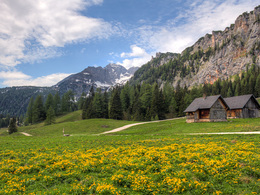Hochmoor Teichlboden - Wurzeralm
Spital am Pyhrn, Oberösterreich, Österreich
Wurzeralm
4582 Spital am Pyhrn
4582 Spital am Pyhrn

jump directly to the Pyhrn-Priel Card Services
The bog Teichlboden on the Wurzeralm in Spital am Pyhrn is one of the most interesting natural areas in Austria
Glaciers had advanced during the last ice age up to the area of the Wurzeralm. This can be still many traces recognize. The onset over the Pyhrnpass glaciation from the Ennstal amounted an elevation of the ice by several hundred meters. The Wurzeralm was up to the surrounding mountain peaks also glaciated. The effluent from the Brunnsteinkar and Frauenkar glacier had about hell and the Pyhrnpass an immediate connection to Ennsgletscher. Only the still flattened peaks of Warscheneck and some other peaks remained free of ice. From still ice-free northern areas came Wollnashorn, cave or cave lion before until now. The former glacier in the Wurzeralm can still acknowledge its landscape-shaping changes. Are residues of natural spruce forests, mountain mixed forests of beech, spruce and fir, or even subalpine larch forests with plenty of rhododendrons highlight the degree of natural landscapes.
Since the Stone Age people in the Wurzeralm as hunters go. But only in the Bronze Age shepherds could penetrate to the cirque to clear even the purpose of grazing forest. At that time could have been started on the Wurzeralm with grazing. The actual pasture is then guaranteed for Wurzeralm since 700 to 800 years.
The Teichl that this bog by pulling water disappears when called Teichlschwund. In resistant rocks such as here on the Wurzeralm weathering process is not overground but as karst underground and thus leads to a widespread cave system. In the Dachstein limestone solution of lime takes place very slowly, and then leads to sinkholes or also typical of the Karst impermeable layers such as the so-called Teichlboden. After crossing these rock faces then dries the Teichl suddenly in limestone bedrock and occurs only in Pichlriß light again. So one of Karst regions quite normal.
The construction of raised bogs
If water silt, first an flat or fen. This is fed by groundwater and the influent from the surrounding water. It can develop alder, sedge stocks also reedbeds. The supply of plants with nutrients is still good. Over time, etc. decomposed as this is a lack of oxygen in the water layer less humus from plant waste such as leaves, dry branches, broken wood. It forms a Torfdecke. If this is higher than 50 cm, only plants can reach the mineral-rich groundwater with deep root systems. Flachwurzler and small plants are dependent on rainwater and zoom gewehte nutrients. We speak of an intermediate Moor. Grows the Torfdecke further - uhrglasförmig bulged - in the height (raised bog), there are the plants only the supply by rainfall and air dust often contains pollen.
The peat mosses are like a sponge volllgesogen with water. Dry even after prolonged good weather from only superficially.
botany
By Teichlboden meanders by lush tall forb corridor narrowly edged the river. In June and July it limit the white flowering Eisenhut Crowfoot, the marsh marigold and globe flower. At the edges of the bog orchids thrive, the bogbean and the rare mountain chives.
Marsh rosemary and cranberry growing in the foreland of Teichlboden-moor.
The top Moor edge forms a dwarf forest.
The secret of Teichlbaches
The Teichl that gives our valley the name that springs to the 1,400 meter high Wurzeralm. At the foot of Warschenecks (2,387 m), in the region of romantic old Brunnsteiner Lake and on the side of Stubwiesalm / neck saddle several springs whose water collects in streams and to u in many meanders through the construction. Fen located on the so-called " Teichlboden overcomes "to" TEICHLSCHWUND ". At this point the water of Teichl disappear quietly and mysteriously in the soil. Not far from the Teichleinfalles there is a rock, and the so-called "ROLLING Luag", where you can still hear the rolling and noise of the disappeared Teichl.
After about 7 km underground watercourses comes HERE THIS POINT most of the Teichlwassers again so quietly out of the ground, as it has disappeared on Wurzeralm above. Above this mysteriously vanished water are the "HÖLL" and Höllgraben where the ancient prehistoric Spitaler petroglyphs were found.
4582 Spital am Pyhrn
Phone +43 7563 249
Fax machine +43 7563 249 - 20
E-Mail spital@pyhrn-priel.net
Web www.urlaubsregion-pyhrn-priel.at
Web skisport.com/de
https://www.urlaubsregion-pyhrn-priel.at
https://skisport.com/de
https://skisport.com/de
Contact person
Tourismusverband Pyhrn-Priel
Bahnhofstraße 2
4580 Windischgarsten
Phone +43 7562 5266
Fax machine +43 7562 5266 - 10
E-Mail info@pyhrn-priel.net
Web www.urlaubsregion-pyhrn-priel.at
Elevation
1300 m
Accessibility / arrivalOnly accessible by funicular Wurzeralm or walk!
- Toilet facility
Discounts (Memberships)
- Pyhrn-Priel-Card
The ride on the funicular to the Wurzeralm is free with the Pyhrn-Priel AktivCard! - Phyrn-Priel seasonal pass
The ride on the funicular to the Wurzeralm is free with the Pyhrn-Priel season card!
- All weather
- Suitable for groups
- Suitable for schools
- Suitable for kids (all ages)
- Suitable for pushchairs
- Pets allowed
- Suitable for teenagers
- Suitable for seniors
- Suitable for single travelers
- Suitable for friends
- Suitable for couples
- Suitable for children
Season
- Spring
- Summer
- Autumn
- Winter
Please get in touch for more information.













